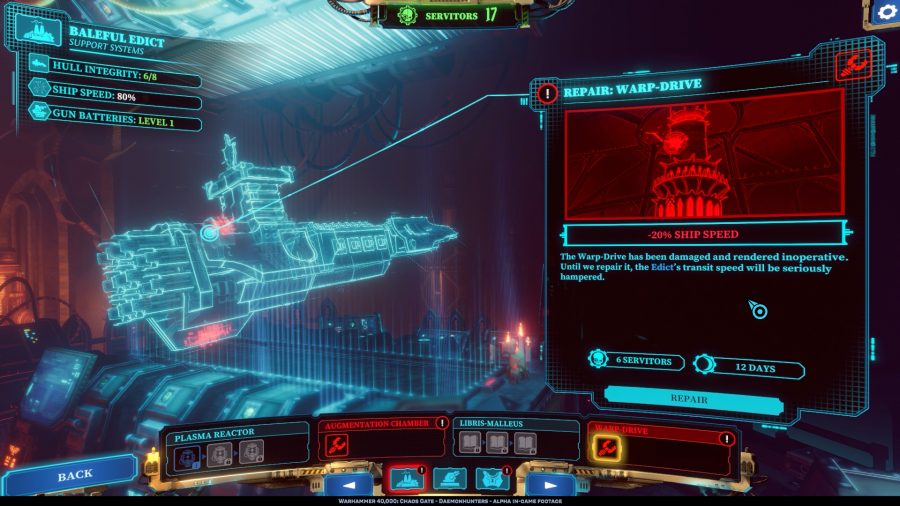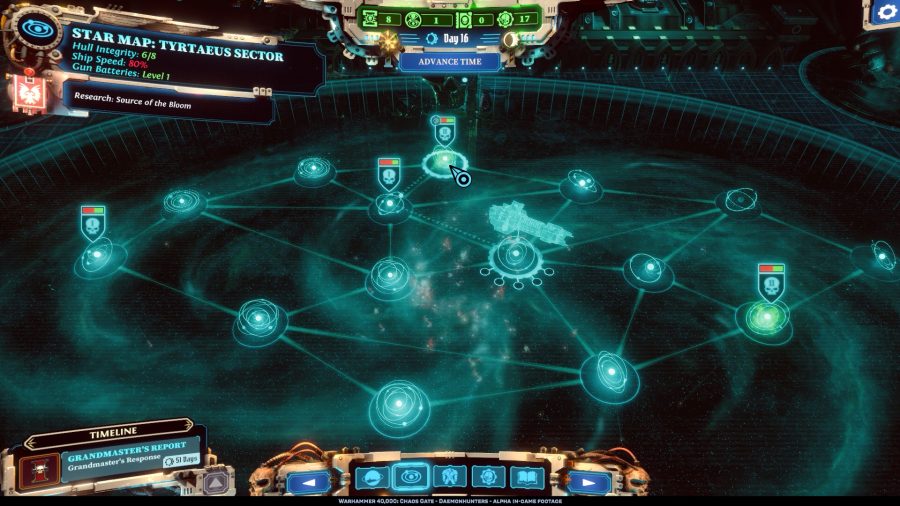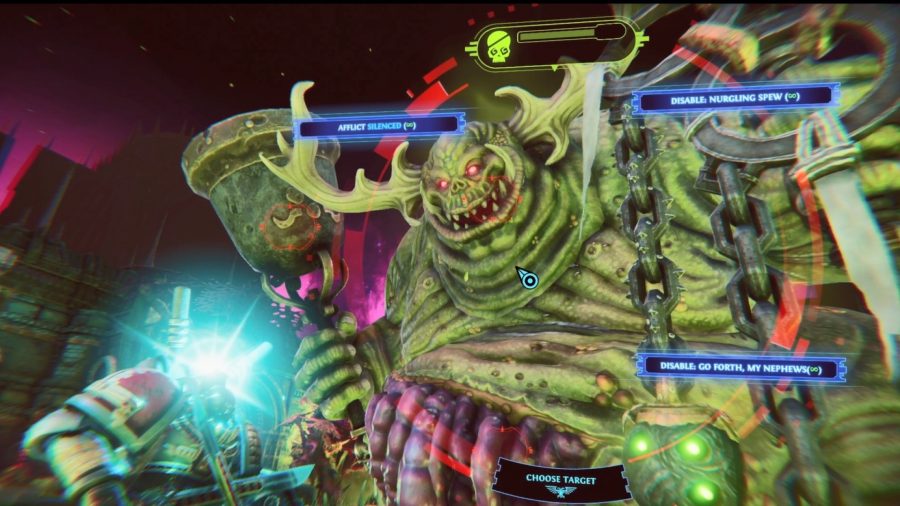If you’re reading our Warhammer 40k: Chaos Gate: Daemonhunters review, chances are you already know the rough shape and structure of this turn-based tactics PC game. We played through three levels last month, and, even at that stage, it was clear Canadian developer Complex Games had nailed the basic formula of ‘XCOM 2 plus Space Marines’. The system worked. We were filled with optimism for a new star in the Warhammer 40k games firmament.
But there were still questions in our minds, beyond that core gameplay. How would the campaign structure play out? Would the characters turn out to be true denizens of 40k, or pale imitations? How difficult would it be to get through missions with all your Grey Knights standing, and press through a campaign run? Could we lose real-life days compulsively fighting through mission after mission and pressing the ‘advance time’ button, like in XCOM?
Well, we’ve now spent around 12 hours in Chaos Gate: Daemonhunters, making stupid campaign mistakes, learning Knight class synergies and tactics through trial and error, and joyfully blowing apart fleshy servants of Nurgle with blessed mass-reactive bolt rounds – and we have bad news and good news.
The bad news is that we’re not ready to give a final score yet, because there’s so much more diseased meat of Daemonhunters left to dig into (including several more classes, enemy types, plague strains, and so much more).
The good news is that – while we don’t love its every aesthetic choice – the game is an outstanding success at its core purpose: finally doing a proper Warhammer XCOM. If you enjoyed XCOM 2, and you like 40k, you will – we promise – get a kick out of Daemonhunters. Complex’s power-armoured romp isn’t without its peccadilloes, though. Let’s review what’s hiding under this (Grey) Knight in shining armour.
What’s a Chaos Gate anyway?
Daemonhunters is nominally a spiritual successor to Random Games’ 1998 PC game Warhammer 40,000: Chaos Gate, which had you command a company of Ultramarines Space Marines (equipping and training each squad, marine, and vehicle) in a campaign against a Chaos lord.
Your psychic space marines are out to defeat a chaos plague – the bloom
Here, the scale is more zoomed in, and the Space Marines more elite and esoteric: you begin the game with command of a heavily damaged Strike Cruiser and half a dozen warriors of the Grey Knights – secret, psychic, daemon-hunting Space Marines with a penchant for sanctioned magic and gold-lettered bling. Though in desperate need of repairs and far from the Chapter’s fortress home on Titan (the largest of Saturn’s 83 moons, btw), after a chance encounter with an Imperial Inquisitor, your Knights are suddenly charged with investigating and eradicating a new, deadly Chaos plague called The Bloom.
As you may have gathered by now, the ‘skeleton’ of the game is lifted almost wholesale from the seminal XCOM 2: you’re given self-evidently insufficient resources, and tasked with single-handedly saving the galaxy from an ever-growing, nearly unassailable threat. You do this by training and deploying elite combat teams to far-flung missions, keeping them alive, and toughening them up for a final face-off with the Big Bad. Never blessed with the resources to complete every mission or research every powerful upgrade, you must make savvy, tricky choices to make sure your plucky force keeps pace with the encroaching enemy, and has the strength to beat them when the time comes. So far, so XCOM.
Where Daemonhunters strays outside the lines of Firaxis’ classic is by giving the combat missions (the real meat of the game) a heavy injection of momentum. Instead of the steady, calculating cover-crawl that characterised much of XCOM’s tactical gameplay (at least until you ‘got gud’), Daemonhunters encourages you to press the attack at nearly every turn.
Keep your squad together and moving fast toward your objective, and you’ll be rewarded by consistently chunky melee damage (boostable with your psychic abilities). There’s also a whole range of synergy abilities that reward quick, coordinated assaults – like automatic supporting fire from a nearby battle brother when you first shoot an enemy, for big damage.
Stay still too long, on the other hand, and gunner enemies will lock you down with Suppression attacks or catch you in Overwatch, inflicting brutal damage when you move or fire. What’s more, every few rounds, the ever-refilling purple meter at the top of the screen gleefully announces another Warp Surge, triggering any one of a whole range of random horrific effects, from resurrecting a couple of nearby Poxwalkers, through to opening warp rifts for whole mobs of extra baddies to pour onto the field
Conclusion: you do not want to hang around.
Enter the Strategium
Chaos Gate: Daemonhunters is a cathartic parade of well-realised Warhammer 40k characters and concepts, brimming with details from the Grey Knights tabletop army to an extent far beyond the representation we’ve seen from most comparable titles.
Your psychic space marines are out to defeat a chaos plague – the bloom
From the beginning, you’ll build your squad from the same specialist marines that make up the tabletop army: tanky squad-leading Justicars; healing-focused Apothecaries; heavy weapon-toting ranged Purgators; and fast-attacking melee Interceptors. The flow of beautifully rendered Grey Knights relic equipment starts very early, too, as missions reward you with requisition items from Nemesis Daemonhammers to Apothecary Servo-Skulls.
There isn’t a giant cast of characters, but the main players are immediately well defined, excellently animated, and mostly very well written and voiced. Andy Serkis‘ performance as the gnarly Grandmaster Vardan Kai – who holds the purse strings for your periodic rewards, ‘XCOM Council’ style – is predictably marvellous; but the other key characters (all of whom have a fair amount of voice acting attached for each phase of the game’s story) also surprised us by actually making us want to talk to them. The testy Adeptus Mechanicus tech priest dominus Lunete was a particular out-of-left-field highlight. Unusually, for the personnel of any Warhammer videogame, these are people we’re actually looking forward to spending more time with!
Blooming hell
Some minor aggravations break the otherwise splendid flow of Daemonhunters’ gameplay.
Some menus and systems – such as ‘attuning’ your ship’s clairvoyant ‘Prognosticars’ to psychically buff certain star systems for campaign benefits – are simply poorly explained. A few others, though – above all the many, many menu hops required to chop and change your Knights and each of their loadouts before a mission – quickly start to feel clunky and annoying. With frequent swaps required to field the right team each time, this feels like a quality of life problem needing fixed.
A few graphical glitches also survive from the preview build we’d played – doors whose ‘kicking in’ animations don’t work, for example – and AI enemies with Overwatch abilities (especially Death Guard marines, for some reason) still deploy them in the wrong direction at least a couple of times per mission. None truly mar the pacing or experience of any level we’ve played yet, but they do sometimes detract from an otherwise high level of immersion.
On the whole, though, Daemonhunters is technically smooth and dependable, gorgeous to look at (as long as you don’t mind the slightly distracting, cartoony faces), and a marvellously made soundscape of squelching daemons, powerful gunshots, and Space Marine vox shouts. It certainly stands out as one of the more technically polished of the Warhammer videogames – and its imperfections are never quite enough to stymy the well-oiled freight train that is the core gameplay loop.
A Knight to remember
We’re far from done with this game, and we can’t give it a final score until we’ve hacked our way through the remaining Nurgle hordes to finish it off. But it’s already a title we can heartily recommend to Warhammer 40k fans in general, and nigh on essential for those who also have a taste for the turn-based tactical gameplay of big daddy XCOM 2.
If you don’t like XCOM 2, you likely won’t enjoy this
If there’s a shade of a downside in Daemonhunters, we suppose it’s just that… it’s so XCOM. For many, that’s exactly what they always wanted, and hey, we’re right there with you. But there are just so many elements of this game – from the delivery and nature of the missions, to the pacing, to the collecting of samples for research – that are good because they’re successfully borrowed from XCOM, that its divergent aspects seem to fade into the background. If you don’t like XCOM, you’ll find little here to enjoy.
Looking beyond that, though, the precedent it sets is especially exciting. Simply using the assets already built for the game, we would love to see a Death Guard campaign, playing as Mortarion and his sons to spread the Bloom and thwart the meddling Grey Knights. But it’s hardly a vast leap of the imagination to see the 40k XCOM formula extended to tell more Warhammer stories from the Imperium, Chaos, and Xenos viewpoints.
A genuinely good Warhammer 40k videogame is like water in the desert to fans – and, now we know Daemonhunters is the real deal, we can’t wait for more of it.
Source: Wargamer










